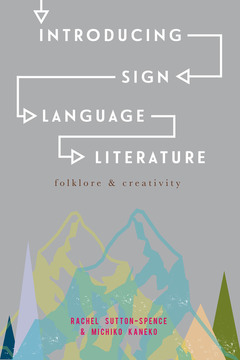Introducing Sign Language Literature, 1st ed. 2016 Folklore and Creativity
Langue : Anglais
Auteurs : Sutton-Spence Rachel, Kaneko Michiko

Introducing Sign Language Literature: Folklore and Creativity is the first textbook dedicated to analyzing and appreciating sign language storytelling, poetry and humour. The authors assume no prior knowledge of sign language or literary studies, introducing readers to a world of visual language creativity in deaf communities.
Introducing Sign Language Literature: Folklore and Creativity
? Explains in straightforward terms the unique features of this embodied language art form
? Draws on an online anthology of over 150 sign language stories, poems and jokes
? Suggests ways of analysing and appreciating the rich artistic heritage of deaf communities
Watch a short video about the book
Introducing Sign Language Literature: Folklore and Creativity
? Explains in straightforward terms the unique features of this embodied language art form
? Draws on an online anthology of over 150 sign language stories, poems and jokes
? Suggests ways of analysing and appreciating the rich artistic heritage of deaf communities
Watch a short video about the book
1. What is Sign Language Literature?.- 2. Sign Language Literature in Context.- 3. Oral Literature and Performance.- 4. Folklore and Deaflore.- 5. Story Types.- 6. Storytelling Techniques.- 7. Anthropomorphism.- 8. Beginnings and Endings.- 9. Plots, Protagonists, Subjects and Themes.- 10. Metaphor.- 11. Prose and Poetry.- 12. Neologism and Ambiguity.- 13. Repetition.- 14. Handshape.- 15. Use of Signing Space.- 16. Symmetry and Balance.- 17. Nonmanual Features.- 18. Deaf Humour and Sign Language Humour.- 19. Style in Signed Art Forms.- 20. Conclusion.
Rachel Sutton-Spence is a lecturer in Sign Language Studies at the Federal University of Santa Catarina in Brazil. She has long been fascinated by sign language poetry and folklore, and has published extensively on linguistic and educational aspects of sign language creativity, humour and metaphor. She is co-author, with Bencie Woll, of The Linguistics of British Sign Language: An Introduction (1999). She taught sign language linguistics and literature at the University of Bristol and to professionals working with sign language within the British Deaf community for many years.
Michiko Kaneko is a Lecturer and Head of the Department of South African Sign Language in the University of the Witwatersrand, Johannesburg. She obtained her PhD in Deaf Studies in the University of Bristol, where she also completed a three-year postdoctoral project titled "Metaphor in Creative Sign Language". Her research interests include sign language linguistics, sign language literature (poetry and stories expressed visually, spatially and manually) and metaphor studies.
Michiko Kaneko is a Lecturer and Head of the Department of South African Sign Language in the University of the Witwatersrand, Johannesburg. She obtained her PhD in Deaf Studies in the University of Bristol, where she also completed a three-year postdoctoral project titled "Metaphor in Creative Sign Language". Her research interests include sign language linguistics, sign language literature (poetry and stories expressed visually, spatially and manually) and metaphor studies.
A groundbreaking new textbook that introduces readers to sign language literature and culture, exploring the forms and functions of signed stories, poems and jokes
Based on courses that have been run at Bristol for over a decade, this is an accessible, studentfriendly text that doesn't assume any knowledge of sign language
Supported by reference to over 150 sign language poems and stories from around the world, as well as online video resources showing performances of creative sign language
Written by leading figures in the field who have worked with students, teachers and professionals around the world, this is an international textbook that is designed for people who use a variety of sign languages
Based on courses that have been run at Bristol for over a decade, this is an accessible, studentfriendly text that doesn't assume any knowledge of sign language
Supported by reference to over 150 sign language poems and stories from around the world, as well as online video resources showing performances of creative sign language
Written by leading figures in the field who have worked with students, teachers and professionals around the world, this is an international textbook that is designed for people who use a variety of sign languages
Date de parution : 04-2016
Ouvrage de 280 p.
15.5x23.5 cm
Retiré de la vente
© 2024 LAVOISIER S.A.S.



